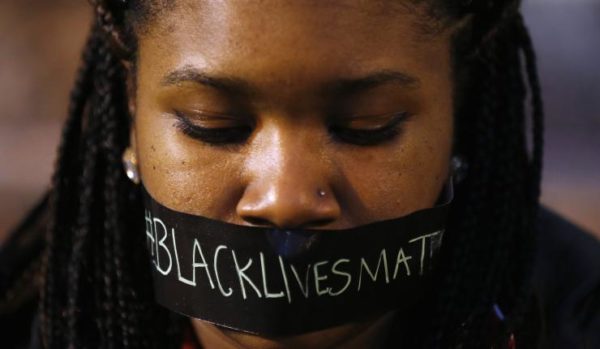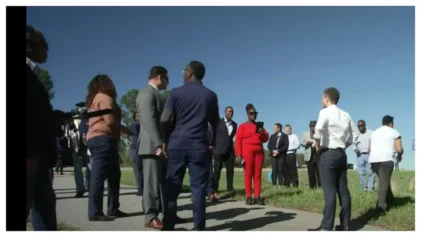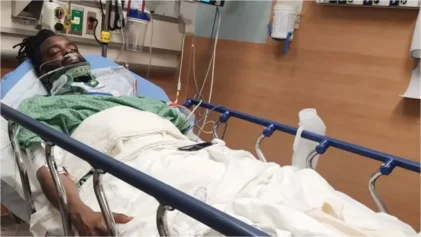
Rather than calling out this act of domestic terrorism for what it was, many people seemed all too ready to wrap the Charleston tragedy up as a religious crime carried out in a church by a deranged fool whose racist ideas were secondary to the location of the carnage.
Now, fast forward to an August morning in Virginia when a Black man shoots dead two of his white former co-workers while they are conducting a live interview on local television news. Since he mentioned Charleston in writings he reportedly sent to a major network and stated he experienced job place discrimination from his victims, media outlets swirled around the branding of “racist,” and pushed to classify the killings as a hate crime. Some FOX News pundits even clamored to call it a case of “reverse racism,” a phenomenon many Black scholars says does not exist but in the minds of those who attempt to minimize the pain of people of color. Not once did anyone ask why this person reacted after not having even worked with those he killed for two years, or whether there was any merit to his claim that workplace racism was his reality. Instead, the discussion turned to guns and hate crimes.
The difference with which the media and others have handled the discussion surrounding both cases begs the question: can racism be traumatic?
Julia Craven pointed out in a June article for the Huffington Post, racism is not a mental illness. Being a racist is not a disease that encompasses the criteria for diagnosis. In fact, most people who are racists, vehemently proclaim, “I don’t have a racist bone in my body,” “I don’t see color,” and the sensitivity-deficient, “I have a black friend.” Still the media perpetuates this notion that racism is an illness that can be cured through love and deferring to Martin Luther King’s “I Have a Dream” speech, not through intense discussion and realization of white supremacy’s overreach into African-American life.
Clearly, people who kill, maim and psychologically torture someone of a different race just because they are of a different race have to be ill, right? To rip people from their native land, stockpile them in the hulls of ships, treat and breed them like animals, then declare their humanity as something that is inhumane must be a kind of evil worthy of a diagnosis in the Diagnostic and Statistical Manual of Mental Disorders, 5th edition (DSM-5)?
While this seems logical to ask, what has not come logically is for the mental health field, as a whole, to ask the counter questions: if racism or acts of racial hatred are viewed as a mental illness, wouldn’t the constant exposure have some effect upon the emotional well-being of those whose identified racial group was the target of said acts? Could prolonged exposure to racist acts, large or small, lead to PTSD (post-traumatic stress disorder) or other ailments? Does race-based trauma have an impact on the physical health of people of color? How are children impacted when they are exposed to racial microaggressions and can’t adequately express themselves? What are the best treatment options for race-based trauma? And finally, how does a community cope with race-based trauma and PTSD?
For some, these are easy questions to answer because studies have shown there to be a connection between racism and trauma. However, the majority of studies have only focused on the incidents one is exposed to, not the actual effect of race-based trauma has upon one’s quality of life. To others, the answer remains elusive because the criteria for diagnosis of PTSD is quite rigid.
Race-based trauma expands the definition of trauma and isn’t just inclusive of racist acts, but also the feelings of hopelessness and helplessness one feels during and after the incidents. Robert T. Carter, Ph.D. wrote on this in a 2006 Psychiatric Times article:
“Race-based traumatic stress injury can be a consequence of emotional pain that a person may feel after encounters with racism, which can be understood in terms of specific types of acts (as distinct types: racial harassment or hostility, racial discrimination or avoidance and/or discriminatory harassment, aversive hostility). How encounters with racism are experienced depends on many factors associated with an individual’s background, health, and cognitive processing. Thus, the person who interprets and appraises his racial encounter as extremely negative (emotionally painful), sudden, and uncontrollable, may exhibit signs and symptoms associated with the stress and possible trauma of racism.”
Racism, in certain cases, is recognized by the American Psychiatric Association (APA) as trauma. Race-based trauma, the experience of the effects of racism, however, is not. Still, PTSD, which may be one way in the experience of race-based trauma could manifest itself, should be considered under these circumstances.
PTSD is defined by the National Center for PTSD (of the U.S. Department of Veterans Affairs) as a chronic condition characterized as “exposure to a traumatic event that meets specific stipulations and symptoms from each of four symptom clusters: intrusion, avoidance, negative alterations in cognitions and mood, and alterations in arousal and reactivity.” These symptoms must occur over a specified period of time, impair overall functioning to some degree and are not caused by alcohol or substance abuse. Among the symptoms of PTSD, eMedicineHealth describes “panic attacks—a feeling of intense fear which can be accompanied by shortness of breath, dizziness, sweating nausea, and a racing heart. Physical symptoms [to include] chronic pain, headaches, stomach pain… tightness or burning in the chest, muscle cramps, or low back pain.”
For a diagnosis of PTSD, one must have either direct exposure to the traumatic event (meaning it happened directly to their person), witnessed the event, learned someone close to them (child, spouse, parent, etc.) experienced the event, or repeated indirect exposure as the result of their job duties. What PTSD criteria does not include is “indirect non-professional” exposure in the form of social media or through televised images.
The impetus of social media and television have made it possible for people to connect to others across the world, quickly and communicate shared interests. Black Lives Matter, which is a response to racial trauma and injustice, has spread in countries like Brazil due largely to social media and televised images. News organizations and sites like Al-Jazeera have connected people in the Middle East with the movement. To ignore the psychological impact of these images, when there is extensive research demonstrating the impact of both, is a fallacy.
Race-based trauma is not just relegated to adults. Children also experience racism and race-based trauma despite their ability to identify it as such.
In children, Dr. Donna Y. Ford, Professor of Education and Human Development at Vanderbilt University says that children are also affected by PTSD and race-based trauma.
“PTSD [in children] can be mild, moderate, and severe. Yes, I believe it is more than reasonable and justified to say that racism can and does contribute to some degree of PTSD among students. This has been found in a few studies, including two recent ones in the last two months. The American Psychological Association (APA) has also written reports on the toll that racism takes on victims of all ages. The effects can be seen in students’ distrust, anxiety and stress, lack of confidence in schools, lowered motivation, decreased self-esteem, concept, and racial pride, to name a few. There are other outcomes, but I am thinking about the psychological toll racism takes on students.”
Dr. Ford was asked how educators should address racism and race-based trauma with school-aged children during a time when it appears to be a weekly occurrence.
“Sadly, I am concerned that not enough educators are being proactive and aggressive about taking on racism in schools, whether it is blatant or covert,” Dr. Ford answered. “Bystanding seems to be the norm, until there is a major crisis that makes the news. This is reactive not proactive and it is disingenuous. Equally troubling is that not enough leaders hold staff accountable by challenging their beliefs and behaviors. I’d love to see more educators being the real world into their classrooms. Social issues are educational issues. Students are well aware of social issues. Imagine how engagement and empowerment would increase when students are connected to real issues, relevant issues, and contemporary issues.”
With regard to students and how they cope with race-based trauma and the impact on their education and learning styles, Dr. Ford says Black teachers are an important force and have an incomparable impact, particularly in closing the achievement gap.
“Teachers’ race matters when it comes to closing achievement gaps. Teachers who are of the same race and culture as their students serve as culture brokers. Another study came out recently that reinforced this. White females represent 75% of teachers nationally. Due to racial, cultural, and gender differences with students—especially Black males, they must be trained to be culturally competent with their students. The lack of Black teachers is problematic, which is clearly one reason President Obama has started My Brothers’ Keeper. The message and need are clear – teachers’ race is critical to improving students’ achievement. Also clear is that cultural competence among the major white and white female teaching force is vital.”
The scope through which PTSD is viewed, again, very narrow and does not take into account the communal nature of some cultures. African-Americans are very community oriented and see ourselves as a collective in which everyone is a participatory, contributing member. As such, when we see members of the collective lying dead on a street in Ferguson, baking in the summer sun for four hours, we can’t help but to feel a kinship connection. That person, Michael Brown, and others like him, whether or not we knew them intimately, were members of the community and we mourn the deaths and the associated injustice as if they were, indeed, family.
For African-Americans and other communities of color, the collective memory of racism lingers. However, it isn’t just memory that plagues the psyche of African-Americans, it is also recent history that is having a major impact on the minds and emotions. Having to reconcile the rhetoric that America has “changed” since the 1960s with experiences that demonstrate otherwise does more than create cognitive dissonance. It alters mood, arousal and reactivity. It impairs functioning, and it is caused by other people working to uphold a system of stratification that is in no way caused by drugs or alcohol. This is PTSD.
Roberts, Gelman, Breslau, Breslau & Koenan (2011) found African-Americans to have the highest lifetime prevalence of PTSD. They also found that African-Americans had a greater risk for PTSD and exposure to traumatic events. They don’t indicate whether those traumatic events are, in fact, race-based. Yet, the experiences of African Americans and other persons of color would support these findings.
Jason Hayes is a community leader and father who has described his experiences across his lifespan and how being an African-American male lends itself to lifetime prevalence of race-based trauma.
“Being raised in Harlem, I have been a victim of police brutality,” he says. “I have grown up worried about my safety, not only from gang violence, but also from police who misuse their power and treat black males as criminals. I feel I have some sort of PTSD because when I am watching police misconduct that leads to the death of innocent people, I know that could have been me or can be me.”
Hayes believes that one way to cope is being more actively involved in the community, engaging youth, and contributing to correcting injustices.
“I do not feel there is enough being done to engage the community on how to interact with law enforcement in a questionable stop,” he says. “I think we need more forums that discuss racism on all levels. When explaining racism to youth, it is important to be honest. Those who are very young need to be taught in small dosages and it should be a continued life-learning experience. This is how I plan on teaching my son and daughter about the racial injustice that exists in the world.”
Many agree with Hayes in regards to using community involvement as a coping strategy, as well as the use of forums to discuss issues and more importantly, feelings. Dr. Raja Staggers-Hakim , a Medical Sociologist and Assistant Professor of Health Sciences and Leadership at Sacred Heart University, concurs.
“I recently began some research with boys between the ages of 14-21 on the impact of police killings on their growth and well being,” Dr. Staggers-Hakim says. “The young African American and Latino boys who I spoke to were justifiably concerned for their well-being and their safety. There was constant concern of being brutalized under mistaken identify and the need to be hyper-vigilant in their actions out of fear that an officer may assume that they are doing something wrong or illegal.”
Dr. Staggers-Hakim offers the following in regards to coping:
“One implication [for treatment and coping] is acknowledging racist events can afford the opportunity to be active in protecting yourself and or engaging in social actions to address oppression. It is important for people to speak about their experiences. Oftentimes people do not speak about their experiences and they somehow feel that theirs is unique. When people begin to speak, the patterns of racial discrimination are acknowledged and it’s possible for people to understand the systemic way in which racism works… there are also groups such as Undoing Racism Organizing Collective (UROC) that host meetings with multiracial and sometimes specific racial groups discuss ways to dismantle racism.”
The effects of race-based trauma can also impact the body. Research shows that there are certain illnesses and conditions that can also be attributed to race-based trauma. Says Dr. Staggers-Hakim, “racism affects the health of people of color, the stress from experienced or perceived discrimination based on race,” Dr. Staggers-Hakim says. “The role of stress on health is well documented. So when people are constantly worried about experiencing racism or are consistently exposed to racism directly, at work, for example, or through witnessing state sanctioned violence such as police brutality, over time, the stress causes wear and tear on the body making people vulnerable to a host of acute (cold or flu) and chronic diseases.”
Dr. Staggers-Hakim says racism is there little doubt of the effect of race-based trauma on the mental health of people of color. However, systemic racism also has some bearing on the health status of poorer African-Americans and other racial minorities.
“We see higher rates of depression, anxiety, and substance abuse,” Dr. Staggers-Hakim says,”but certainly, there are other indirect pathways through which racism affects health from unfair and illegal sitting of toxic substances such as ‘brownfields’ and landfills referred to as environmental racism which are disproportionately located nearer to communities where Black and Brown people reside. Hence, the are higher rates of asthma, chronic bronchitis and certain cancers in lower income communities of color than more affluent communities. Resource distribution such as limited access to parks, green spaces and grocery stores in poor and minority communities are yet another way we see how racially biased policies affect health.”
When it comes to discussing feelings, however, African-Americans are more likely to seek spiritual guidance as opposed to formal treatment. One reason may be in the desire to connect with a therapist or doctor of color who can understand the impact racism has not only on the mind, but also on the soul. According to Mental Health America, proper diagnosis and access to effective treatment modalities are further complicated by a shortage of African-Americans in the mental health field. The statistics cited by Mental Health America are less than 2 percent of psychiatrist and psychologists, respectively, and less than 4 percent of social workers are identified as African-American. Essentially, those who cannot identify are likely to undiagnosed, misdiagnosed and/or fail to properly treat African-Americans who may be experiencing PTSD as a result of race-based trauma.
The DSM-5 does not recognize race-based trauma and has no common assessment for studying the affects of this phenomenon. What the DSM-5 does recognize, is PTSD, and if it can be extended to Holocaust victims and their descendants, it could very well be applied to people of color whose daily experiences are littered with overt racist interactions as well as the more subtle, passive aggressive ones.
For race-based trauma with PTSD to become fully recognized by the DSM, a task force and work groups would have to be convened by the American Psychiatric Association. It already took nearly 20 years to determine how the 5th edition manual will be modified. The APA spent an estimated $20-25 million producing the DSM-5. The modifications were approved by the APA board of trustees in 2012.
The approved definition of a mental disorder was changed from the DSM-IV version of a mental disorder being “a clinically significant behavioral or psychological syndrome or pattern that occurs in an individual and that is associated with present distress or disability or with a significantly increased risk of suffering death, pain, disability, or an important loss of freedom.”
The new approved DSM-5 definition reads: “a syndrome characterized by clinically significant disturbance in an individual’s cognition, emotion regulation, or behavior that reflects a dysfunction in the psychological, biological, or developmental processes underlying mental functioning. Mental disorders are usually associated with significant distress in social, occupational, or other important activities. An expectable or culturally approved response to a common stressor or loss, such as the death of a loved one, is not a mental disorder.”
The DSM-5 assertion of what is “culturally approved” does not explicitly state which “culture” they are referring to, however, if it is majority American culture, then it is invariably white.
ABPSi, The Association of Black Psychologists, issued the following response to those changes:
“We share a concern about the apparent change to the definition of mental disorder. As written, it would diminish the role of socio-cultural factors in mental distress, and users of the manual would be charged with determining whether mental disorder is the primary or secondary result of deviance or social conflicts. The possibility that socio-political deviance could be labeled as a mental disorder would have clearly negative consequences for African Americans specifically, given our history of activism and resistance to oppression, discrimination, and prejudice. In addition, many in the nation are currently engaging in political action related to the nation’s economic system; these individuals would be at risk for inappropriate diagnosis according to the revised definition of mental disorder. Mental distress does not happen in a vacuum; it is vital to continue to articulate that an assessment and understand of context is necessary for the appropriate treatment of mental distress.”
Some are already rushing at the attempt to label the Black Lives Matter movement as a hate group. Given the revised DSM-5 definition, it stands to reason those wanting to dismiss Black folk’s agency will move to classify any type of organized Black political action as a mental illness, when the movements themselves are healthy ways of outwardly coping with race-based trauma and seeking justice.
According to some reports, in the 20 years since the last DSM revision, more African-Americans were murdered by law enforcement than were reported lynched under Jim Crow. African-Americans suffered by the government’s neglect during Hurricane Katrina. African-American children in the south are more likely to be suspended from school. A judge was recently charged with “selling” Black children to corporate prisons, and some former members of Texas law enforcement posted a video on Facebook speaking of a plan to harm what he deemed “Black thugs,” calling Sandra Bland a “thug” for questioning the officer who was clearly in the wrong.
Yet only a small percentage of those participating in the DSM revision work-groups were African-American psychologists whose concerns that lowering the threshold for some disorders would lead to over-medicating Black children. All this happened between 1995 and 2015 as revisions to criteria and diagnoses were under consideration.
Still, race-based trauma with PTSD wasn’t even considered for inclusion in the new DSM-5. Unfortunately, it seems the APA doesn’t find these race-based instances traumatic enough.


